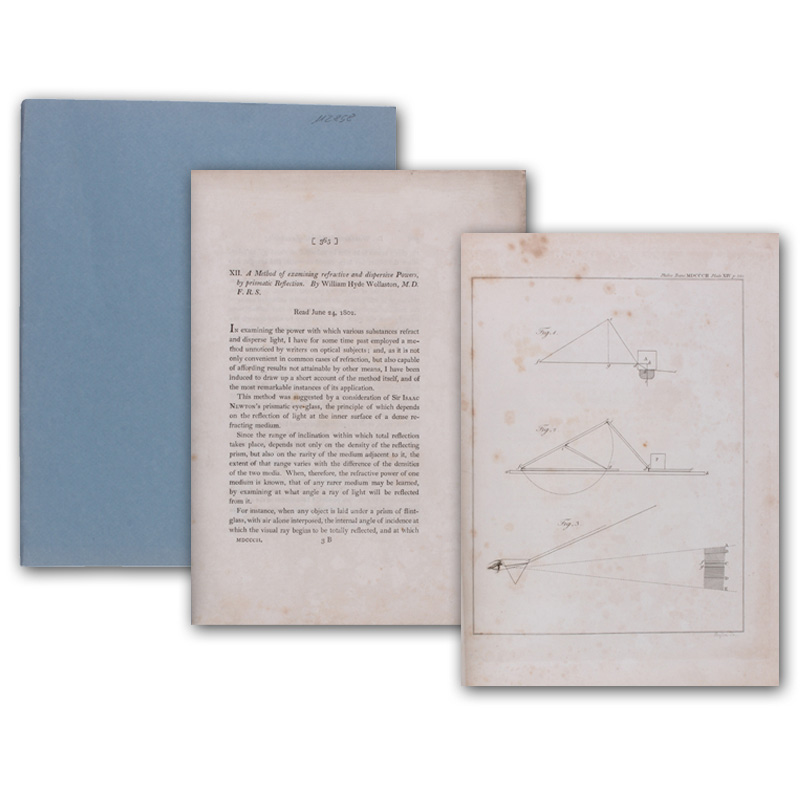112858-01
A method of examining refractive and dispersive powers, by prismatic reflection.
(London, 1802). - (29 x 23,5 cm). SS. 365-386. Mit 1 Kupfertafel. Moderne Broschur, unbeschnitten. (Aus: Philosophical Transactions of the Royal Society).
Erste Ausgabe. - "In 1802 Wollaston introduced the important method of determining refractive indices by total internal reflection. The alternative method of minimum deviation, however, continued to be used in the early part of the century. His observations on an impure spectrum led him to conclude that there were only four colors in the solar spectrum. This influenced Thomas Young, who was led by it to alter his own theory of color vision. At the same time Wollaston discovered the dark lines in the solar spectrum, later to be known as Fraunhofer lines. Also in 1802 he presented convincing experimental support for Huygens’ wave theory. Using the technique he had invented, he measured the refractive index of Iceland spar in different directions and showed that for different planes of incidence the extraordinary ray was refracted exactly as Huygens’ theory predicted. He did not commit himself, however, to a firm statement of belief in the wave theory. This later brought Wollaston charges of timidity and undue caution; but there was no reason why he should have gone further, particularly since Young’s impressive evidence had not yet appeared" (DSB). - Gering fleckig, sonst gut erhalten. - DSB 14, 486
A method of examining refractive and dispersive powers, by prismatic reflection.
(London, 1802). - (29 x 23,5 cm). SS. 365-386. Mit 1 Kupfertafel. Moderne Broschur, unbeschnitten. (Aus: Philosophical Transactions of the Royal Society).
Erste Ausgabe. - "In 1802 Wollaston introduced the important method of determining refractive indices by total internal reflection. The alternative method of minimum deviation, however, continued to be used in the early part of the century. His observations on an impure spectrum led him to conclude that there were only four colors in the solar spectrum. This influenced Thomas Young, who was led by it to alter his own theory of color vision. At the same time Wollaston discovered the dark lines in the solar spectrum, later to be known as Fraunhofer lines. Also in 1802 he presented convincing experimental support for Huygens’ wave theory. Using the technique he had invented, he measured the refractive index of Iceland spar in different directions and showed that for different planes of incidence the extraordinary ray was refracted exactly as Huygens’ theory predicted. He did not commit himself, however, to a firm statement of belief in the wave theory. This later brought Wollaston charges of timidity and undue caution; but there was no reason why he should have gone further, particularly since Young’s impressive evidence had not yet appeared" (DSB). - Gering fleckig, sonst gut erhalten. - DSB 14, 486
480 €

